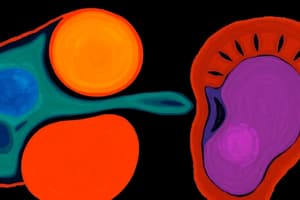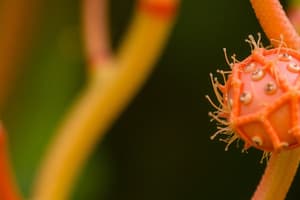Podcast
Questions and Answers
Which of the following is the primary outcome of reproduction?
Which of the following is the primary outcome of reproduction?
- To allow organisms to adapt to new environments.
- To ensure the survival and continuation of a species. (correct)
- To create offspring that are genetically superior to the parents.
- To improve the physical appearance of organisms.
What is the fundamental difference between sexual and asexual reproduction?
What is the fundamental difference between sexual and asexual reproduction?
- Asexual reproduction leads to greater genetic diversity than sexual reproduction.
- Asexual reproduction requires two parents, while sexual reproduction requires only one.
- Sexual reproduction produces more offspring than asexual reproduction.
- Sexual reproduction involves the fusion of gametes, while asexual reproduction does not. (correct)
How do offspring produced through sexual reproduction generally compare to their parents?
How do offspring produced through sexual reproduction generally compare to their parents?
- They are exact genetic copies of a single parent.
- They lack genetic material from either parent.
- They are genetically identical to both parents.
- They exhibit variations and are not exact copies of their parents. (correct)
What is the role of 'sex cells' in sexual reproduction?
What is the role of 'sex cells' in sexual reproduction?
Which of the following best describes external fertilization?
Which of the following best describes external fertilization?
How do viviparous animals differ from oviparous animals in terms of reproduction?
How do viviparous animals differ from oviparous animals in terms of reproduction?
What is the role of pollination in the sexual reproduction of flowering plants?
What is the role of pollination in the sexual reproduction of flowering plants?
How does self-pollination differ from cross-pollination?
How does self-pollination differ from cross-pollination?
What is the main characteristic of asexual reproduction?
What is the main characteristic of asexual reproduction?
In binary fission, how does the parent organism divide?
In binary fission, how does the parent organism divide?
How does fragmentation lead to asexual reproduction?
How does fragmentation lead to asexual reproduction?
What is vegetative reproduction?
What is vegetative reproduction?
How do plants reproduce through runners?
How do plants reproduce through runners?
Which of the following is an example of artificial propagation method?
Which of the following is an example of artificial propagation method?
What is the key function of budding and grafting in artificial propagation?
What is the key function of budding and grafting in artificial propagation?
What is the purpose of using a sterile medium in tissue culture?
What is the purpose of using a sterile medium in tissue culture?
What is the result of sequential hermaphroditism?
What is the result of sequential hermaphroditism?
How does 'protandry' differ from 'protogyny' in sequential hermaphroditism?
How does 'protandry' differ from 'protogyny' in sequential hermaphroditism?
Which adaptation would NOT aid a plant in attracting pollinators?
Which adaptation would NOT aid a plant in attracting pollinators?
How does fragmentation in starfish contribute to their reproduction?
How does fragmentation in starfish contribute to their reproduction?
Flashcards
Reproduction
Reproduction
Biological process where an organism reproduces an offspring similar to itself.
Sexual Reproduction
Sexual Reproduction
Fusing two sex cells to create a zygote, usually requiring two parents and resulting in varied offspring.
Oviparous
Oviparous
Organisms deposit eggs in the external environment.
Ovoviviparous
Ovoviviparous
Signup and view all the flashcards
Viviparous
Viviparous
Signup and view all the flashcards
Pollination
Pollination
Signup and view all the flashcards
Self-Pollination
Self-Pollination
Signup and view all the flashcards
Cross-Pollination
Cross-Pollination
Signup and view all the flashcards
Asexual Reproduction
Asexual Reproduction
Signup and view all the flashcards
Binary Fission
Binary Fission
Signup and view all the flashcards
Budding
Budding
Signup and view all the flashcards
Fragmentation
Fragmentation
Signup and view all the flashcards
Parthenogenesis
Parthenogenesis
Signup and view all the flashcards
Vegetative Reproduction
Vegetative Reproduction
Signup and view all the flashcards
Cutting
Cutting
Signup and view all the flashcards
Study Notes
- Reproduction is a biological process where an organism creates biologically similar offspring.
Importance of Reproduction
- Procreation ensures the continuation of species.
- Quality improvement occurs through genetic variation.
Types of Reproduction
- Sexual Reproduction involves the fusion of two sex cells to form a zygote, usually requiring two parents and resulting in offspring with variations.
- Asexual Reproduction does not involve the fusion of sex cells and requires only one parent, producing genetically identical offspring or clones.
Sexual Reproduction Details
- Fusion of two sex cells creates a zygote.
- Two parents are usually needed.
- Offspring exhibit variations and are not identical to the parents.
Types of Cells
- Somatic or body cells include 22 pairs.
- Sex cells consist of one pair and include sperm and egg cells.
- Sexual reproduction in animals occurs in gametogenesis, spawning/mating, and fertilization.
Male and Female Reproductive Systems
- The male reproductive system produces and deposits sperm.
- The female reproductive system produces egg cells.
- Male reproductive organs produce sperm cells (spermatogenesis), are regulated by hormones, and vary across species.
- Female reproductive organs produce egg cells (oogenesis), undergo the ovarian and uterine cycle (menstrual cycle), and are regulated by hormones.
Sequential Hermaphroditism
- Species are born as one sex but can change into the other.
- Protogyny involves a change from female to male.
- Protandry involves a change from male to female.
Types of Fertilization
- External Fertilization happens outside the body, especially in aquatic animals.
- Internal Fertilization happens inside the body of the female, as in reptiles and mammals (including humans).
Animal Classification by Birth
- Oviparous animals deposit eggs in the external environment.
- Ovoviviparous animals retain eggs in their bodies, releasing young that can fend for themselves.
- Viviparous animals do not lay eggs; young develop inside the mother's body and are born independently.
Sexual Reproduction in Plants
- Flowering plants reproduce sexually through pollination.
- Pollination transfers pollen grains from the male anther to the female stigma.
Types of Pollination
- Self-pollination occurs when pollen moves from stamen to stigma of the same plant.
- Cross-pollination occurs when pollen moves to the stigma of another plant.
Asexual Reproduction
- Asexual Reproduction doesn't involve the fusion of sex cells.
- It requires only one parent.
- Offspring are clones, genetically identical to the parent.
Types of Asexual Reproduction
- Binary Fission involves the division of the body into two or more equal parts (e.g., bacteria, paramecium, amoeba).
- Budding involves a new organism developing as an outgrowth or bud from the parent body (e.g., hydra, yeast).
- Fragmentation involves the parent body breaking into pieces, each growing into a new individual (e.g., starfish, worms, fungi, lichen).
- Parthenogenesis involves unfertilized eggs developing into new offspring (e.g., bees, wasps, ants).
Vegetative Reproduction
- Vegetative Reproduction uses plant parts like roots, stems, and leaves to reproduce.
Types of Vegetative Reproduction
- Natural vegetative reproduction occurs through specialized reproductive structures.
- Artificial propagation is aided by humans.
Natural Vegetative Reproduction
- Natural vegetative reproduction uses vegetative parts or specialized reproductive structures.
- It primarily involves modified stems like runners, tubers, corms, and rhizomes.
Types of Natural Vegetative Reproduction
- Runners are new plants arising from nodes of above-ground horizontal stems.
- Strawberries use horizontal stems on the soil surface to reproduce.
Budding and Grafting
- Small stems attach to larger stems or roots of another plant.
- Examples include some fruits and nut trees.
Tissue Culture
- Tissue Culture involves placing pieces of tissue from one plant on a sterile medium to grow new individuals in mass numbers.
Genetically Identical Offspring
- Genetically identical offspring are produced by particular type of reproduction.
True or False directives
- Self-pollinating plants can fertilize themselves, while cross-pollinating plants need a vector to transfer pollen.
- Plants use physical characteristics to attract pollinators.
- Animals/insects that transfer pollen are called "pollinators."
- Fragmentation is not a type of asexual reproduction.
- Vegetative reproduction uses plant parts to reproduce.
Studying That Suits You
Use AI to generate personalized quizzes and flashcards to suit your learning preferences.




